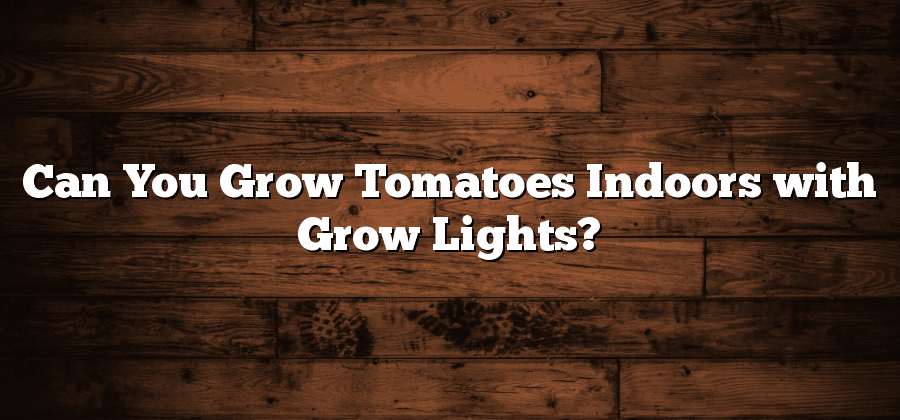Benefits of Growing Tomatoes Indoors
Indoor gardening has gained immense popularity in recent years, and one of the top contenders for indoor cultivation is tomatoes. Growing tomatoes indoors offers a wide range of benefits to gardeners of all levels. Firstly, it allows for year-round cultivation, eliminating the limitations imposed by seasonal changes and adverse weather conditions. With indoor gardening, you can enjoy fresh, flavorful tomatoes anytime you want, irrespective of the weather outside. Moreover, growing tomatoes indoors provides greater control over the growing environment, including temperature, humidity, and lighting, allowing for optimal growing conditions and thus maximizing yield.
Another significant advantage of growing tomatoes indoors is the ability to protect your plants from pests and diseases. Indoor gardening minimizes the risk of infestations and allows for early detection and prompt treatment, ensuring healthy growth and high-quality tomatoes. Additionally, indoor cultivation reduces the reliance on harmful pesticides and herbicides, resulting in a more sustainable and eco-friendly approach to gardening. By growing tomatoes indoors, you can have peace of mind knowing that your plants are safe from external threats and that you are providing your family with safe, chemical-free produce.
Ideal Conditions for Indoor Tomato Growth
In order to ensure optimal growth and productivity, providing the ideal conditions for indoor tomato growth is crucial. Firstly, it is important to maintain a consistent temperature range between 70 to 75 degrees Fahrenheit during the daytime and a slightly lower temperature range of 60 to 65 degrees Fahrenheit during the night. Tomatoes thrive in warm and stable conditions, so it is vital to avoid any drastic fluctuations in temperature.
Aside from temperature, humidity levels also play a significant role in the success of indoor tomato growth. A relative humidity of around 50 to 70 percent is recommended to ensure healthy plant development. To achieve this humidity range, consider using a humidifier or placing a tray of water near the tomato plants to increase moisture in the air. Additionally, adequate air circulation is essential to prevent the buildup of stale air and promote healthy growth. This can be achieved by using fans or ensuring that the indoor space has proper ventilation.
Choosing the Right Grow Lights for Tomatoes
When it comes to growing tomatoes indoors, choosing the right grow lights is key to ensuring successful and healthy plant growth. While natural sunlight is the best source of light for plants, it may not be sufficient or accessible for growing tomatoes indoors. This is where artificial grow lights come into play, providing the necessary light spectrum and intensity to mimic sunlight.
One important factor to consider when choosing grow lights for tomatoes is the type of light they emit. LED (Light Emitting Diode) grow lights have become increasingly popular among indoor gardeners due to their energy efficiency and customizable light spectrum. LED lights provide a balanced combination of red and blue wavelengths, which are essential for promoting photosynthesis and healthy growth in tomato plants. Additionally, LED lights produce less heat, reducing the risk of heat stress and allowing the lights to be placed closer to the plants without causing damage.
Another important consideration is the light intensity emitted by the grow lights. Tomatoes require a high amount of light, with an optimal range of 1500-2000 lux (lumens per square meter). Therefore, it is crucial to choose grow lights that can provide sufficient brightness to support the growth and development of tomato plants. The light intensity should be adjustable to suit the different stages of the plant’s growth, such as seedling, vegetative, and flowering stages. By selecting grow lights with the right intensity and spectrum, indoor gardeners can ensure optimal conditions for their tomato plants and enjoy a bountiful harvest.
Understanding Light Requirements for Tomatoes
When it comes to understanding the light requirements for tomatoes, it is important to note that these plants thrive in full sunlight outdoors. However, when growing tomatoes indoors, replicating the intensity and duration of natural sunlight becomes essential for their successful growth. Tomatoes require at least 10-12 hours of direct light each day to produce optimal yields.
To meet their light requirements, indoor tomato gardens often rely on artificial grow lights. Choosing the right type of grow lights for tomatoes is crucial as it directly affects their growth and overall health. LED grow lights are highly recommended for indoor tomato cultivation due to their energy efficiency and ability to provide a full spectrum of light. These lights emit wavelengths that are essential for photosynthesis and thus promote healthy growth and fruiting in tomato plants. Additionally, LED lights generate minimal heat, reducing the risk of damaging the plants or causing temperature-related stress.
Setting Up an Indoor Tomato Garden
When it comes to setting up an indoor tomato garden, there are a few key factors to consider to ensure the success of your plants. First and foremost, selecting the right containers is crucial. Opt for pots or grow bags that have drainage holes to prevent waterlogged roots. Additionally, choose a potting mix that is well-draining and rich in nutrients to provide an optimal growing medium for your tomato plants.
Another important aspect to consider is the location of your indoor tomato garden. Tomatoes thrive in warm temperatures, so it is advisable to place your plants in a spot that receives at least six hours of direct sunlight each day. If your chosen location does not provide enough natural light, you may need to supplement with artificial lighting. This leads us to our next point: choosing the right grow lights for tomatoes.






